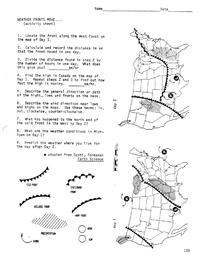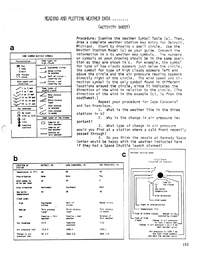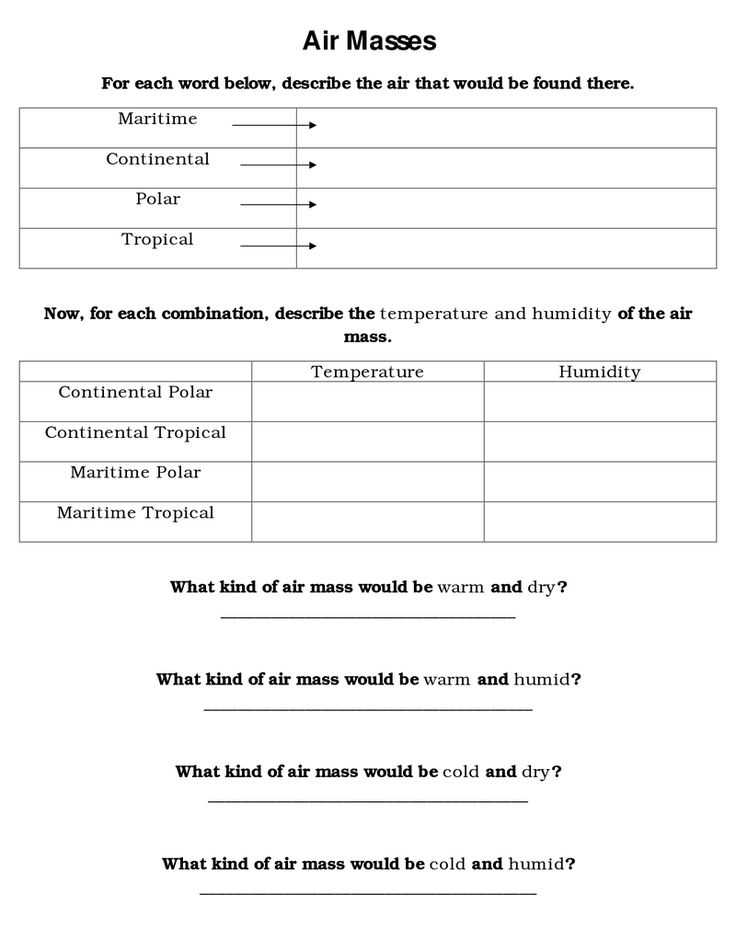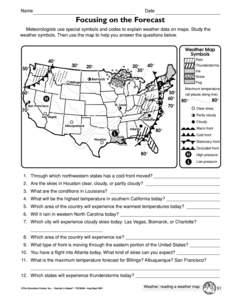Weather Map Fronts Worksheet
Understanding weather fronts is essential for any aspiring meteorologist or weather enthusiast. Whether you're a student studying meteorology or a curious individual interested in predicting the weather, our weather map fronts worksheet is the perfect resource to enhance your knowledge. Designed to provide a comprehensive understanding of weather fronts, this worksheet is ideal for those who want to delve deeper into the subject and gain a solid foundation in meteorology principles.
Table of Images 👆
More Other Worksheets
Kindergarten Worksheet My RoomSpanish Verb Worksheets
Cooking Vocabulary Worksheet
DNA Code Worksheet
Meiosis Worksheet Answer Key
Art Handouts and Worksheets
7 Elements of Art Worksheets
All Amendment Worksheet
Symmetry Art Worksheets
Daily Meal Planning Worksheet
What is a weather map front?
A weather map front is a boundary between two air masses with different temperature, humidity, and pressure characteristics. It is represented on weather maps by line symbols such as cold fronts, warm fronts, stationary fronts, and occluded fronts, indicating how these air masses interact and influence weather patterns, such as the formation of clouds, precipitation, and changes in temperature.
How are weather map fronts represented on a weather map?
Weather map fronts are represented by colored lines on a weather map, with each line showing the boundary between two different air masses. The different types of fronts, such as cold fronts, warm fronts, stationary fronts, and occluded fronts, are depicted with specific symbols and colors to indicate the type of weather conditions that can be expected along that front. Cold fronts are usually shown in blue with triangles pointing in the direction of movement, while warm fronts are typically depicted in red with half circles also pointing in the direction of movement.
What are the different types of weather map fronts?
There are four main types of weather map fronts: cold fronts, warm fronts, stationary fronts, and occluded fronts. Cold fronts occur when a cold air mass advances and replaces a warmer air mass. Warm fronts form when a warm air mass replaces a cooler air mass. Stationary fronts occur when a warm and cold air mass meet but neither advances. Occluded fronts happen when a cold front catches up to a warm front, forcing the warm air mass aloft. Each of these fronts plays a key role in shaping weather patterns and conditions.
What characteristics determine the type of front?
The characteristics that determine the type of front include the temperature difference between the air masses, the moisture content of the air masses, and the speed at which the air masses are moving. Warm fronts occur when warm air moves in over colder air, while cold fronts occur when cold air advances over warmer air. Stationary fronts occur when neither air mass is advancing, and occluded fronts form when a cold front overtakes a warm front. The interaction of these characteristics influences the type of front that is formed.
How do cold fronts affect the weather?
Cold fronts typically bring changes in weather conditions, as they represent the boundary where a cold air mass is advancing and replacing a warmer air mass. As the cold air moves in and displaces the warm air, it can lead to the formation of clouds, precipitation, and sometimes even thunderstorms. The temperature usually drops, winds can become gusty, and there may be a sudden shift in atmospheric pressure. Overall, cold fronts can bring cooler temperatures, rainfall, and sometimes severe weather events to an area as they pass through.
How do warm fronts impact the weather?
Warm fronts bring warmer air into an area, which can lead to a rise in temperature, increased humidity, and often produce periods of prolonged precipitation such as steady rain or drizzle. As the warm air rises over the colder air mass, it can cause clouds to form, potentially leading to overcast skies and possible thunderstorms. Additionally, warm fronts are typically associated with a shift in wind direction and lower atmospheric pressure, which can result in changes in weather conditions such as gusty winds and occasionally severe weather events.
What weather conditions are associated with stationary fronts?
Stationary fronts are associated with extended periods of cloudy or precipitous weather, including continuous rain, showers, thunderstorms, or snow. This is because the front is not moving and is more likely to bring prolonged periods of unsettled atmospheric conditions. Additionally, the boundary between the warm and cold air masses at a stationary front can create a wide range of weather phenomena, such as fog, mist, and sometimes even severe weather like tornadoes or heavy rainfall.
What are the characteristics of an occluded front?
An occluded front is characterized by the meeting of a warm front and a cold front, with the cold front overtaking the warm front. This leads to a combination of weather patterns typically associated with both fronts, including precipitation, cloud cover, and sometimes thunderstorms. The air behind an occluded front is typically colder and denser than the air ahead of it, resulting in a mix of weather conditions such as rain or snow.
How do occluded fronts influence the weather?
Occluded fronts occur when a faster-moving cold front overtakes a slower-moving warm front, leading to the warm air being lifted above the colder air. This lifting of warm air causes it to cool and condense, resulting in the formation of clouds and precipitation. The weather associated with occluded fronts can include prolonged periods of precipitation, sometimes heavy, and can lead to a variety of weather conditions such as rain, snow, or even thunderstorms. Additionally, occluded fronts often bring strong winds and changes in temperature, contributing to shifts in weather patterns and atmospheric conditions.
How can weather map fronts help predict future weather patterns?
Weather map fronts can help predict future weather patterns by showing the boundaries between air masses with different temperatures and humidity levels. By tracking the movement and interactions of these fronts, meteorologists can anticipate the development of storms, precipitation, and changes in temperature. For example, a warm front moving into an area can indicate rising temperatures and potential rain, while a cold front can bring cooler temperatures and possible thunderstorms. By analyzing the position and movement of weather map fronts, forecasters can make educated predictions about how weather patterns will evolve in a specific region over time.
Have something to share?
Who is Worksheeto?
At Worksheeto, we are committed to delivering an extensive and varied portfolio of superior quality worksheets, designed to address the educational demands of students, educators, and parents.























Comments